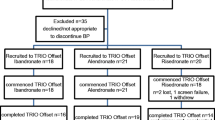Abstract
There is little information available concerning compliance with pharmacologic therapy for osteoporosis in the usual care setting. We evaluated 176 consecutive, previously untreated women whose physicians initiated treatment for osteoporosis following a bone mineral density (BMD) test obtained as part of routine medical practice. All patients were contacted ≥1 year after the initial BMD test and offered a follow-up BMD. Compliance with therapy was defined as the percent of time that a patient filled a prescription for osteoporosis treatment. Ninety-three (53%) patients received estrogen (ERT), 93 (53%) bisphosphonates, 8 (5%) calcitonin, and 17 (10%) received more than one therapy. Ninety-one of the 176 (52%) agreed to a follow-up BMD at a mean of 590 days after the first study (participants); 85 declined a follow-up BMD (refusers). Participants and refusers were similar for age, treatment patterns, and compliance with therapy. For all patients, compliance for those given bisphosphonate was similar to those given ERT (70.7% (95% CI 63.5–77.9%) versus 69.2% (95% CI 61.7–76.8%). For participants, the change in spine BMD was similar for those treated with bisphosphonate [mean increase 3.53 (±2.64)%/year (mean±SD)] and those treated with ERT [mean increase 3.00 (±2.75)%/year]. For those participants whose compliance with therapy was ≥66%, the mean increase in spine bone density was 3.80 (±2.59)%/year compared to 2.11 (±2.64)%/year (p<0.005) for those whose compliance was <66%. Compliance with ERT and bisphosphonate therapy initiated in routine practice after a BMD was similar over a mean of 590 days. Compliance less than 66% with drug treatment results in suboptimal improvement in bone density.
Similar content being viewed by others
References
The Writing Group for the PEPI Trial (1996) Effects of hormone therapy on bone mineral density: Results from the postmenopausal estrogen/progestin interventions (PEPI) trial. JAMA 276:1389–1396
Ettinger B, Black DM, Mitlak BH et al (1999) Reduction of vertebral fracture risk in postmenopausal women with osteoporosis treated with raloxifene: results from a 3-year randomized clinical trial. JAMA 282:637–645
Chesnut CH III, Silverman S, Andriano K et al (2000) A randomized trial of nasal spray salmon calcitonin in postmenopausal women with established osteoporosis: the prevent recurrence of osteoporotic fractures study. PROOF study group. Am J Med 109:267–276
Black DM, Cummings SR, Karpf DB et al (1996) Randomised trial of effect of alendronate on risk of fracture in women with existing vertebral fractures. Fracture Intervention Trial Research Group. Lancet 348:1535–1541
Harris ST, Watts NB, Genant HK et al (1999) Effects of risedronate treatment on vertebral and nonvertebral fractures in women with postmenopausal osteoporosis: a randomized controlled trial. Vertebral efficacy with risedronate therapy (VERT) study group. JAMA 282:1344–1352
Andrade SE, Walker AM, Gottlieb LK et al (1995) Discontinuation of antihyperlipidemic drugs—do rates reported in clinical trials reflect rates in primary care settings? N Engl J Med 332:1125–1131
Frolkis JP, Pearce GL, Nambi V, Minor S, Sprecher DL (2002) Statins do not meet expectations for lowering low-density lipoprotein cholesterol levels when used in clinical practice. Am J Med 113:625–629
Ryan PJ, Harrison R, Blake GM, Fogelman I (1992) Compliance with hormone replacement therapy (HRT) after screening for postmenopausal osteoporosis. Br J Obst Gyn 99:325–328
Torgerson DJ, Donaldson C, Russell IT, Reid DM (1995) Hormone replacement therapy: compliance and cost after screening for osteoporosis. Eur J Obst Gyn Repro Bio 59:57–60
Ettinger B, Pressman A, Silver P (1999) Effect of age on reasons for initiation and discontinuation of hormone replacement therapy. Menopause 6:282–289
Ettinger B, Pressman A (1999) Continuation of postmenopausal hormone replacement therapy in a large health maintenance organization: transdermal matrix patch versus oral estrogen therapy. Am J Manag Care 5:779–785
Kayser J, Ettinger B, Pressman A (2001) Postmenopausal hormonal support: discontinuation of raloxifene versus estrogen. Menopause 8:328–332
den Tonkelaar I, Oddens BJ (2000) Determinants of long-term hormone replacement therapy and reasons for early discontinuation. Obstet Gynecol 95:507–512
Ettinger B, Pressman A, Schein J, Chan J, Silver P, Connolly N (1998) Alendronate use among 812 women: prevalence of gastrointestinal complaints, noncompliance with patient instructions, and discontinuation. J Managed Care Pharm 4:488–492
Greendale GA, Wells B, Marcus R, Barrett-Connor E (2000) How many women lose bone mineral density while taking hormone replacement therapy? Results from the postmenopausal estrogen/progestin interventions trial. Arch Intern Med 160:3065–3071
Acknowledgment
This study was supported by a grant from SmithKline Beecham Pharmaceuticals, Philadelphia, PA, USA
Author information
Authors and Affiliations
Rights and permissions
About this article
Cite this article
Yood, R.A., Emani, S., Reed, J.I. et al. Compliance with pharmacologic therapy for osteoporosis. Osteoporos Int 14, 965–968 (2003). https://doi.org/10.1007/s00198-003-1502-4
Received:
Accepted:
Published:
Issue Date:
DOI: https://doi.org/10.1007/s00198-003-1502-4




